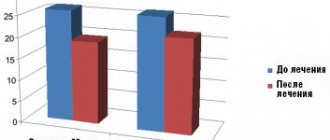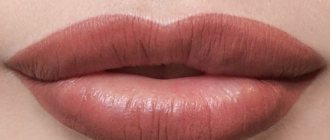What is sinusitis?
Sinusitis refers to inflammatory diseases of the paranasal sinuses (sinusitis).
Attention! In this case, the sinuses, located on both sides of the nose in the bones of the upper jaw, become inflamed. These maxillary sinuses become inflamed equally often in children and adults.
The main purpose of such cavities is to equalize pressure in the external environment and intracranial bones. Such processes occur due to communication between the cavities and the nose through narrow openings.
If inflammatory processes develop, these sinuses become blocked and phlegm and mucus begin to accumulate in them .
In it, when the disease is of infectious origin, pathogenic microflora develops, which aggravates the symptoms.
Swelling of the face in the eye area in this case is due to the fact that the inflamed sinuses are located close to such areas, and with an increase in the size of the inflamed tissues, this manifests itself visually.
In this case, sinusitis can be one-sided or affect both sinuses, and in the first case, swelling of the eye and face occurs only on the side of the inflamed eye.
Diagnostics
Diagnosis of diseases that are accompanied by swelling of the nasal cavity is carried out by otolaryngologists. The examination program includes a survey, during which the specialist determines the time and circumstances of the appearance of swelling and other symptoms, their relationship with various external and internal factors. The doctor conducts an external examination and prescribes the following diagnostic procedures:
- Rhinoscopy.
Allows you to confirm the presence of inflammation, deformities, tumors, polyps, foreign bodies and traumatic injuries. - Lab tests
. A microbiological examination of nasal discharge is performed to detect bacterial infections, and RIF to detect viral diseases. For tumors, histological or cytological examination is prescribed. - Radiography
. In case of injuries, photographs of the nose are taken, and if sinusitis is suspected, X-rays of the paranasal sinuses are taken.
The listed methods can be supplemented by allergy tests, studying the condition of the pharynx and larynx during pharyngoscopy and laryngoscopy, and other studies.
Rhinoendoscopy
Why does swelling of the eyes and face develop with sinusitis?
Initially, swelling with sinusitis occurs in the sinuses.
At the same time, experts argue that this is not only a consequence of the development of inflammation, but also an additional protection of the body from pathogenic microorganisms entering the body through the nose (swelling narrows the maxillary sinuses and acts as an additional barrier).
Know! It is useless to eliminate the swelling itself during sinusitis, and if the root causes of the pathology are not identified in time and treatment is not started, the inflammatory processes continue to spread and spread to the face in the eye area.
The reason for the development of such swelling may be :
Signs of a malignant process
The root cause of the development of nasal cancer has not been determined. There are risk factors that provoke the appearance of a tumor:
- Active (to a greater extent) and passive smoking.
- Work in hazardous industries: interaction with flour dust, wood, textiles, leather goods.
- Prolonged contact with radium, chrome and nickel dust, formaldehyde, solvents, and other chemical compounds.
- Chronic forms of various variants of sinusitis, rhinitis.
- Alcohol abuse.
- Long stay in a place with unfavorable ecology.
- Viral infection (for example, human papillomavirus).
When determining the stage of nasal cancer, experts pay attention to the following points:
- The spread of the process to other sinuses, soft tissues of the face, bone fragments.
- The presence or absence of metastases in regional lymph nodes - those closest to the diseased organ.
- The presence or absence of metastases distant from the lesion.
Symptoms
With the development of edema, the integrity of the nasal mucosa is always compromised, resulting in the area of damage expanding over time.
Keep in mind! As a result, swelling spreads to the periocular area and appears in the form of reddened swelling.
The following symptoms are typical for edema that occurs precisely because of sinusitis :
- rapid breathing due to partial narrowing of the airways;
- redness of the lower (less often upper) eyelids ;
- change in voice timbre;
- swelling of the eyelids and parts of the cheeks directly under the eyes ;
- headache;
- accumulation of pus in the maxillary sinuses , which is periodically discharged through the nose.
The severity of the pathology can be judged by the swelling.
The stronger these symptoms are, the further the disease progresses.
Therefore, if symptoms increase and home methods at hand are ineffective, you should immediately consult a doctor.
Possible complications
When we talk about cancer, complications almost always arise. But their character depends on the process itself, its distribution, and the anatomical structures that are nearby and involved in this process.
The most common complications of nasal cancer include the following:
- vision is impaired. When nasal cancer is in its final stage, the disease spreads to the eyes, brain, and skull. Due to this pathology, the functioning of organs, as well as vision, is disrupted;
- problems related to food arise. Since the tumor grows with nasal cancer, it becomes difficult for a person to open his mouth and chew food. These moments contribute to general exhaustion, weight loss;
- there is a risk that the disease will relapse;
- metastasis. If cancer of the paranasal sinuses is in the last stages, then metastases may occur, during which the lymph nodes will be affected.
Causes of childhood suffering
The causes of severe swelling of the nasal mucosa in a child are different:
- allergic: exposure to allergens on the mucous membrane;
- infectious: bacterial and viral origin;
- acquired: the appearance of tumors in the nose and herniation of the brain;
- traumatic: after surgery or injury to the nose;
- congenital: curvature of the nasal septum, pathological narrowing of the nasal passage.
Having established the root cause of swelling of the bridge of the nose and mucous membrane, it is possible to correctly prescribe treatment and significantly make the child’s life easier.
Swelling of the nose after rhinoplasty. Recommendations for patients
Alexander Alexandrovich Markushin daily performs several plastic surgeries on the nose and other parts of the body of varying complexity.
Thanks to the excellent equipment of the clinic and vast experience, Dr. Markushin can easily cope with any task. Up to eighty percent of people seeking help come not only for aesthetic, but also for medical reasons, in order to restore normal breathing. The remaining twenty percent of patients want only an aesthetic improvement in the appearance of the nose.
Rhinoplasty, successfully performed by a specialist, still requires long-term rehabilitation. Each body reacts differently to surgery. Only by strictly following the recommendations of your doctor can you speed up the regeneration process.
Why and in what areas does swelling appear after rhinoplasty?
The most common problem after nose surgery is the appearance of swelling in different parts of the face. The abundance of capillaries and blood vessels on the underlying tissues, close to the operated areas, causes numerous bruises and swelling. Injury to the epidermis leads to inflammation and the appearance of numerous microbleeds. Blood soaking into tissues through damaged vessels located near the operation site leads to the formation of bruises. When intercellular fluid accumulates in one place under the skin, it forms swelling.
Most of the trauma during rhinoplasty is caused to the tissues of the back or wings of the nose. In addition, the surgeon’s actions are reflected in the spaces near the eyes, cheeks, or lips located nearby and connected by the same circulatory system.
After the operation, you need to wait for the appearance of blue circles near the eyes, swelling of the cheeks and lips. Despite the fact that at the preliminary consultation each patient is warned about external manifestations, the first impression can still cause a panic attack.
The plastic surgeon, having completed the work, explains how the body’s recovery will proceed, and offers the optimal set of medications, ointments, and gels to speed up the regeneration process.
How long will swelling and bruising last after rhinoplasty?
Each body reacts differently to external influences. There are no universal methods that are equally suitable for every patient who has undergone surgery. It is impossible to predict how much time and effort will be required until the bruises and swelling disappear.
Most people notice improvement within a day or three days. Self-regeneration of tissue leads to fluid outflow and uniform distribution over adjacent areas. At the same time, small compactions and swelling can persist for up to a year, although their presence is noticeable only to specialists.
Swelling is most severe after osteotomy, when part of the skeleton of the bone base is removed, which injures the periosteum.
How quickly patients get rid of edema is demonstrated by the statistics collected by Dr. Markushin.
Immediately after rhinoplasty
Correction of a deviated septum, changes in the shape, size, and configuration of the nose results in severe swelling. The maximum concentration of bruises and swelling will occur on days 4-5.
1 week after rhinoplasty
The peak of tissue changes with distinct bruises and severe swelling appears at the end of the first seven days, after which they begin to go away.
2-3 weeks after rhinoplasty
At this time, the plaster splint is usually removed, and the swelling, no longer controlled by it, begins to gradually increase. Maximum swelling in the vast majority of patients after complex operations will persist for 2-3 weeks.
1 month after rhinoplasty
After completing the fourth week, most patients get rid of maximum swelling and blue spots on the face, which makes it possible to begin normal household duties and go to work.
2-3 months after rhinoplasty
Swelling of the operated periosteum lasts the longest, up to 2-3 months. A slight swelling is noticeable on the back and tip of the nose.
4-5 months after rhinoplasty
In the fifth month of rehabilitation, internal swelling of the mucous membrane or periosteum is felt by the patient or doctor when palpating the surgical site.
6 months after rhinoplasty
By this time the swelling usually goes away completely. The nose becomes thin. During this period, it is already possible to evaluate the result of rhinoplasty.
1 year after rhinoplasty
As a rule, starting from 6 to 12 months, there is no longer tissue edema. By one year the nose has healed completely.
Important!!!
An increase in swelling or the appearance of new bruises indicates the occurrence of internal inflammatory processes. This is a signal for immediate consultation with your doctor. A special course of physiotherapy or a set of additional medications may be needed.
Ways to reduce swelling and fight bruises
The main thing is not to panic when your face becomes unusually plump with blue streaks. Panic will not produce results, but will only negatively affect the psychosomatic state.
Alexander Alexandrovich will recommend the necessary procedures and medications so that regeneration occurs as quickly as possible.
After simple correction, swelling may disappear within a few hours or be insignificant.
For the first week of rehabilitation, it is recommended to follow simple rules so that swelling disappears as quickly as possible:
- a semi-sitting position during sleep or rest will reduce the flow of blood and fluid to the inflamed areas;
- no massages, deep palpations, decorative cosmetics for the first 5-7 days;
- avoid direct sunlight, high air temperature in the apartment, baths, saunas, swimming pools, hot water baths;
- Physical activity, yoga or sports with the head tilted forward are not allowed.
Recommendations for the second and third weeks of recovery after surgery:
- You should not sleep lying on your stomach or side. Organize your rest in such a way that you lie face up;
- exclude the possibility of sudden displacement of the underlying tissue or areas of skin located close to the operation site;
- Do not heat the area of swelling or drink hot drinks;
- You can do normal household chores if they do not require sudden bending or excessive effort.
To speed up the process of tissue restoration, the doctor prescribes a set of gels and ointments with components that accelerate the recovery process, reduce the risk of inflammation, and increase the outflow of fluid.
Giving up bad habits will help reduce swelling in 3-4 months. Smoking and alcohol stimulate blood flow, which causes swelling and bruising on the back of the nose or its tip. It is necessary to take care of contact lenses in advance for people suffering from low vision, so as not to wear glasses until the surgical site heals.
Alexander Alexandrovich is always in touch. He is ready to advise on any issue. Be sure to see a specialist if the swelling does not go away after the fourth month.
How to behave if swelling remains unchanged for a long time?
Any unusual situations must be resolved quickly. If pain increases, swelling increases, or new bruises appear after surgery, contact your rhinoplasty surgeon as soon as possible. The quality of tissue regeneration processes is affected by age, the presence of chronic diseases, or violation of the regimen prescribed by the doctor. In addition, each body reacts individually to surgical intervention; additional factors appear that slow down the process of restoration of damaged areas of the body.
The doctor will examine the surgical site. He will make sure that the presence of swelling and bruising does not indicate inflammation developing at the site of the operation, but is just a reaction of the body that goes beyond the boundaries of the normal recovery process. An additional course of procedures is prescribed to accelerate the outflow of fluid and increase microcirculation.
Alexander Alexandrovich guides his patients until their final recovery, carefully monitoring the dynamics of the body’s recovery after a complex operation.
Combined drug Vibrocil for nasal congestion
The medicine contains antiallergic substances dimethindene and phenylephrine. The first, when applied topically, inhibits the activity of histamine receptors; Phenylephrine has a vasoconstrictor effect. Vibrocil is produced in the form of nasal gel, spray and drops.
Drops are used for allergic rhinitis, ARVI and colds in children over 12 months.
How to remove nasal congestion in a child using Vibrocil:
- For children aged 1 to 6 years, instill the product three times a day, 1-2 drops into each nasal passage.
- If your child has nasal congestion at night and swelling of the bridge of the nose, use nasal gel.
- To treat a child over 6 years old, you can use Vibrocil drops, spray or gel.
- Immediately before using the product, clear the nasal passages of accumulated mucus.
The drug does not have a hypnotic effect. Experts recommend using Vibrocil for no longer than 1–2 weeks. You cannot, at your own discretion, change the dosages indicated by the doctor and listed in the instructions for the medicine.











